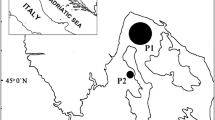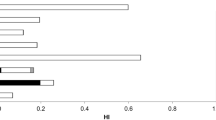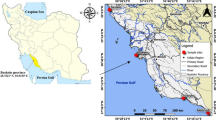Abstract
This study aimed to evaluate cadmium (Cd) and lead (Pb) levels in seafood and perform a risk assessment based on individual food consumption frequency of inhabitants of the Aratu Bay, Brazil. From December 2013 to November 2014, ready-to-market seafood, including fish [pititinga (Lile piquitinga) and small green eel (Gobionellus oceanicus)], mollusks [mussel (Mytella guyanensis) and oyster (Crassostrea rhizophorae)], and crustaceans [white shrimp (Litopenaeus schmitti) and blue crab (Callinectes exasperatus)], were purchased bimonthly from a local artisanal shellfish harvester. Metal levels were analyzed by graphite furnace atomic absorption spectrometry (GFAAS). Based on the volunteer’ seafood consumption, estimates of the non-carcinogenic target hazard quotients (THQs) were calculated. The annual concentrations (μg/g, w/w) of Cd were 0.007 (±0.001) in crustaceans, 0.001 (±0.0003) in fish, and 0.446 (±0.034) in mollusks. Lead levels were <limit of detection (LOD) in crustaceans, 0.044 (±0.0032) in fish, and 0.111 (±0.009) in mollusks. All values were within the international guidelines. We observed that 90.9 % of the responders presented an average THQ < 1, which is classified as negligible risk; however, 9.1 % presented THQs between ≥1 and <9.9. These data are important to inform the community of the imminent exposure risk through communication strategies, with the purpose of minimizing exposure and, consequently, the health effects associated with it.



Similar content being viewed by others
References
Ali, M. M., Ali, M. L., Islam, S., & Rahman, Z. (2016). Preliminary assessment of heavy metals in water and sediment of Karnaphuli River, Bangladesh. Environmental Nanotechnology, Monitoring and Management. doi:10.1016/j.enmm.2016.01.002.
Amado-Filho, G. M., Salgado, L. T., Rebelo, M. F., et al. (2008). Heavy metals in benthic organisms from Todos os Santos Bay, Brazil. Brazilian Journal of Biology, 68(1), 95–100.
Antunes, C. G. C. (2006). Analysis of Rhizophora mangle L. leaves submitted to the environmental impacts of the municipality of Santo Amaro–Bahia (p. 75). Bahia: Monograph, Catholic University of Salvador.
ATSDR - Agency for toxic substances and disease registry. (2013). Minimal risk levels for hazardous substances. Washington. Available at: http://www.atsdr.cdc.gov/mrls.html. Access jan 2015.
Bahia. (1980). Department of Industry and Trade. Department of Industry and Trade. Master Plan CIA (Industrial Centre Aratu). Salvador, Bahia, Brazil, 67
Bonfim, I.C.V. (2005). Environmental quality assessment of mangrove areas impacted by industrial activities of the Todos os Santos Bay. Dissertation (master), Federal University of Ceara, Brazil, 116.
Brandão, G.C. (2010). Sample preparation alternative strategies for the determination of metals in foods by atomic absorption spectrometry flame. Dissertation (master)—Federal University of Bahia, Institute of Chemistry, Salvador, Bahia, Brazil, 95.
Brazil (1988). Ministry of Health. Health Surveillance Secretariat. Approves the technical regulation: general principles for maximum levels of establishment of chemical contaminants in food and its annex maximum tolerance limits for inorganic contaminants. Ordinance 685, 27/08/1998
Brazil (2009). Ministry of Agriculture, Livestock and Supply. Instruction 24, 14/07/2009. Defines the requirements and criteria for operation of the waste analysis laboratories and contaminants in food members of the National Agricultural Laboratory Network. Official Gazette. Brasília, Section I, 138, 7
Brazil. (2010). Ministry of Fisheries and Aquaculture. Statistical bulletin of fisheries and aquaculture—Brazil 2010. Brasília: MPA
Brazil. (2013). National Health Surveillance Agency. Mercosur technical regulation on maximum contaminant inorganic in food. RDC 42, 29/08/2013
Brito, R.R.C. (1997). Capítulo I: Ambientes aq. Chapter I: aquatic environments. Part II: the Bay of All Santos today—natural Scenery. In: UFBA-NIMA. Todos os Santos Bay: environmental diagnosis and allowance for management. Bahia: Germen, 69–78
Celino, J. J., & Queiroz, A. F. S. (2006). Source and degree of contamination by polycyclic aromatic hydrocarbons (PAHs) Low molecular mass of sediment. Todos os Santos Bay, Bahia. REM: Copper Mines School, 59, 265–270.
Copat, C., Arena, G., Fiore, M., Ledda, C., Fallico, R., Sciacca, R., & Ferrante, M. (2013). Heavy metals concentrations in fish and shellfish from eastern Mediterranean Sea: consumption advisories. Food Chemical Toxicology, 53, 33–37. doi:10.1016/j.fct.2012.11.038.
Costa, A.B., Zucchi, M.R., Azevedo, A.E.G., Santos, V.L.C.S., Azevedo, E.R., Bonagamba, T.J., (2008). Characterization of organic matter in sediments of Todos os Santos Bay. In: Queiroz, A.F., Celino, J.J. (Eds.). Environments evaluation in Todos os Santos Bay. RECUPETRO_PROAMB. 173–187.
CRA (2005). Preliminary analysis of risk to human health. Summary report. Consortium BTS Hydros CH2MHILL. State Government of Bahia. 43.
European Commission - Cowi. (2002). Heavy metals in waste: final report. Denmark: Cowi A/S. Available at: <http://ec.europa.eu/environment/waste/studies/pdf/heavy_metalsreport.pdf>. Access: 12 dez. 2014.
Ferreira, A.N. (2011). Dredging impact assessment on phytoplankton association Porto de Aratu, Todos os Santos Bay–Salvador. Dissertation (master) Postgraduate Program in Geochemistry: Oil and the Environment - POSPETRO, Institute of Geosciences, University Federal da Bahia, 73.
Garcia, K. S., De Oliveira, O. M. C., & De Araújo, B. R. N. (2008). Leaves of biogeochemistry Avicennia Schaueriana in the northern Todos os Santos Bay. In A. F. Queiroz & J. J. Celino (Eds.), Environment evaluation in Todos os Santos Bay (pp. 213–232). Salvador: PROAMB, UFBA.
Glass, D. C., Kelsall, H. L., Slegers, C., et al. (2015). A telephone survey of factors affecting willingness to participate in health research surveys. BMC Public Health. doi:10.1186/s12889-015-2350-9.
Guérin, T., Chekri, R., Vastel, C., Sirot, V., Volatier, J.-L., Leblanc, J.-C., & Noël, L. (2011). Determination of 20 trace elements in fish and other seafood from the French market. Food Chemistry, 127, 934–942.
Harrison, J. M., Jung, M., Lennie, T. A., et al. (2016). Refusal to participate in heart failure studies: do age and gender matter? Journal of Clinical Nursing. doi:10.1111/jocn.13135.
Hatje, V., Bícego, M. C., Carvalho, G. C., & Andrade, J. B. (2009). Todos os Santos Bay: oceanographic aspects/chemical contamination (p. 306). Salvador: EDUFBA.
Horta, M. A. P., Ferreira, A. P., Luzardo, A. J. R., Brignol, V., Brasil, V. I., Faro, A. R. M. C., et al. (2011). Risk analysis of cadmium intake by fish consumers in a sub-tropical coastal Lagoon, Sepetiba Bay-Se, Brazil. Journal of Health Promotion, 24(1), 46–53.
IBGE, Brazilian Institute of Geography and Statistics. (2010). Consumer Expenditure Survey 2008–2009: household food acquisition per capita. Rio de Janeiro. Available at: http://www.ibge.gov.br/home/estatistica/populacao/condicaodevida/pof/2008_2009_encaa/pof_20082009_encaa.pdf. Access 09/12/2014.
Iupac, International Union of Pure and Applied Chemistry. (1997). Chemistry compendium of chemical terminology. 2. Available at: http://old.iupac.org/publications/compendium/. Access 12/12/2014.
Kibria, G., Hossain, M., Mallick, D., et al. (2016). Trace/heavy metal pollution monitoring in estuary and coastal area of Bay of Bengal, Bangladesh and implicated impacts. Marine Pollution Bulletin. doi:10.1016/j.marpolbul.2016.02.021.
Kim, D., Bloom, M. S., Parsons, P. J., Fitzgerald, E. F., Bell, E. M., Steuerwald, A. J., & Fujimoto, V. Y. (2013). A pilot study of seafood consumption and exposure to mercury, lead, cadmium and arsenic among infertile couples undergoing in vitro fertilization (IVF). Environmental Toxicology Pharmacology, 36, 30–34. doi:10.1016/j.etap.2013.02.006.
Krishna, P. V., & Madhusudhana Rao, K. M. (2014). Human health risk assessment of heavy metal accumulation through fish consumption, from Machilipatnam Coast, Andhra Pradesh, India. International Research Journal of Public and Environmental Health, 1(5), 121–125.
Liu, P., Wang, C.-N., Song, X.-Y., & Wu, Y.-N. (2010). Dietary intake of lead and cadmium by children and adults—result calculated from dietary recall and available lead/cadmium level in food in comparison to result from food duplicate diet method. International Journal of Hygiene Environmental Health, 213, 450–457. doi:10.1016/j.ijheh.2010.07.002.
Martins, R.J.E. (2004). Accumulation and release of heavy metals by aquatic brióftas. Thesis (PhD in Chemical Engineering)—University of Porto, Porto, Portugal. 650.
Mendoza-Carranza, M., Sepúlveda-Lozada, A., Dias-Ferreira, C., & Geissen, V. (2016). Distribution and bioconcentration of heavy metals in a tropical aquatic food web: a case study of a tropical estuarine lagoon in SE Mexico. Environmental Pollution. doi:10.1016/j.envpol.2015.12.014.
Menezes-Filho, J. A., Paes, C. R., Pontes, A. M. C., Moreira, J. C., Sarcinelli, P. N., & Mergle, D. (2009). High levels of hair manganese in children living in the vicinity of a ferro-manganese alloy production plant. Neurotoxicology. doi:10.1016/j.neuro.2009.04.005.
Menezes-Filho, J. A., de Novaes, C. O., Moreira, J. C., Sarcinelli, P. N. S., & Mergler, D. (2011). Elevated manganese and cognitive performance in school-aged children and their mothers. Environmental Research. doi:10.1016/j.envres.2010.09.006.
Menezes-Filho, J. A., Carvalho-Vivas, C. F., Viana, G. F. S., Ferreira, J. R. D., Nunes, L. S., Mergler, D., & Abreu, N. (2014). Elevated manganese exposure and school-aged children’s behavior: a gender-stratified analysis. Neurotoxicology. doi:10.1016/j.neuro.2013.09.006.
Morgano, M. A., Oliveira, A. P. F., Rabonato, L. C., Milani, R. F., Vasconcellos, J. P., Martins, C. N., et al. (2011). Evaluation of inorganic contaminants (As, Cd, Cr, Hg e Pb) species of fish. Journal Institute Adolfo Lutz., 70, 497–506.
Morgano, M. A., Rabonato, L. C., Milani, R. F., Miyagusku, L., & Quintaes, K. D. (2014). As, Cd, Cr, Pb and Hg in seafood species used for sashimi and evaluation of dietary exposure. Food Control. doi:10.1016/j.foodcont.2013.07.036.
MPA. (2013). Ministry of Fisheries and Aquaculture. Statistical bulletin of fisheries and aquaculture, Brazil. Brasília. Available at: http://www.mpa.gov.br/images/Docs/InformacoeseEstatisticas/Boletim%20MPA%202011FINAL.pdf. Access 14/12/2014.
Noël, L., Vastel, C., Chekri, R., Chafey, C., Testu, C., & Guérin, T. (2009). Evaluation of 10-years French NRL proficiency tests for lead, cadmium and mercury analysis in foodstuff of animal origin. Microchemical Journal. doi:10.1016/j.microc.2009.01.001.
Olmedo, P., Pla, A., Hernández, A. F., Barbier, F., Ayouni, L., & Gil, F. (2013). Determination of toxic elements (mercury, cadmium, lead, tin and arsenic) in fish and shellfish samples. Risk assessment for the consumers. Environment International. doi:10.1016/j.envint.2013.05.005.
Petroczi, A., & Naughton, D. P. (2009). Mercury, cadmium and lead contamination in seafood: a comparative study to evaluate the usefulness of Target Hazard Quotients. Food Chemical Toxicology. doi:10.1016/j.fct.2008.11.007.
Psoma, A. K., Pasias, I. N., Rousis, N. I., Barkonikos, K. A., & Thomaidis, N. S. (2014). Development, validation and accreditation of a method for the determination of Pb, Cd, Cu and As in seafood and fish feed samples. Food Chemistry. doi:10.1016/j.foodchem.2013.11.045.
Sanches Filho, P. J., Da Fonseca, V. K., & Holbig, L. (2013). Metals assessment in fish of the region Pontal da Barra, Lagoon dos Patos, Pelotas-RS. Ecotoxicology And Environmental Contamination. doi:10.5132/eec.2013.01.015.
Santos, L. F. P., Trigueiro, I. N. S., Lemos, V. A., et al. (2013). Assessment of cadmium and lead in commercially important seafood from São Francisco do Conde, Bahia, Brazil. Food Control. doi:10.1016/j.foodcont.2013.02.024.
Sartori, A. G. O., & Amancio, R. D. (2012). Fish: nutritional importance and consumption in Brazil. Food and Nutrition Security, 19, 83–93.
Storelli, M. M. (2008). Potential human health risks from metals (Hg, Cd, and Pb) and polychlorinated biphenyls (PCBs) via seafood consumption: estimation of target hazard quotients (THQs) and toxic equivalents (TEQs). Food Chemical Toxicology. doi:10.1016/j.fct.2008.05.011.
US EPA—United States Environmental Protection Agency. (2013). Risk assessment information system—RISK. Available at: <http://rais.ornl.gov/cgi-bin/prg/RISK_search?select=chem>. Access: January 2015.
Viana, F., Huertas, R., & Danulat, E. (2005). Heavy metal levels in fish from coastal waters of Uruguay. Environmental Contamination and Toxicology, 48, 530–537.
Viana, G. F. S., Carvalho, C. F., Nunes, L. S., et al. (2014). Noninvasive biomarkers of manganese exposure and neuropsychological effects in environmentally exposed adults in Brazil. Toxicology Letters. doi:10.1016/j.toxlet.2014.06.018.
Wang, S.-L., Xu, X.-R., Sun, Y.-X., Liu, J.-L., & Li, H.-B. (2013). Heavy metal pollution in coastal areas of South China: a review. Marine Pollution Bulletin. doi:10.1016/j.marpolbul.2013.08.025.
World Health Organization—WHO. (1989). Environmental health criteria 85: lead—environmental aspects. Geneva: ONU.
World Health Organization—WHO. (1991). Environmental health criteria 118: inorganic mercury. Geneva: ONU.
World Health Organization—WHO. (1995). Environmental health criteria 165: inorganic lead. Geneva: ONU.
Acknowledgments
We would like to express our thankfulness to the inhabitants of the Santa Luzia community who participated as volunteers in this study. This investigation was partially supported by the Federal University of Bahia Bolsa de Produtividade em Pesquisa grant number 7081/2014 and a master’s scholarship to Araujo, C.F.S. from Fundação de Apoio a Pesquisa do Esato da Bahia (FAPESB).
Author information
Authors and Affiliations
Corresponding author
Ethics declarations
Conflict of interest
The authors declare that there are no conflicts of interest.
Rights and permissions
About this article
Cite this article
da Araújo, C.F.S., Lopes, M.V., Vasquez, M.R. et al. Cadmium and lead in seafood from the Aratu Bay, Brazil and the human health risk assessment. Environ Monit Assess 188, 259 (2016). https://doi.org/10.1007/s10661-016-5262-y
Received:
Accepted:
Published:
DOI: https://doi.org/10.1007/s10661-016-5262-y




